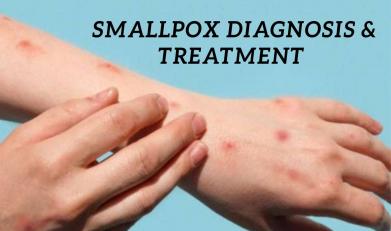

28 Jun, 2024
Smallpox, caused by the variola virus, is a severe and contagious disease that has left a significant mark on human history. Despite its eradication in 1980, thanks to a global vaccination campaign led by the World Health Organization (WHO), understanding the diagnosis and treatment of smallpox remains essential. This knowledge is crucial for historical understanding, biosecurity, and preparing for any potential future outbreaks, whether natural or as a result of bioterrorism.
Initial Symptoms
Smallpox begins with non-specific symptoms that can easily be mistaken for other illnesses:
Fever: Often high, appearing suddenly.
Malaise: A general feeling of discomfort or illness.
Headache and Backache: These are severe and persistent.
Vomiting: Sometimes present.
Rash Development
After the initial symptoms, the characteristic smallpox rash appears in stages:
Macules: Red spots on the tongue and in the mouth, which then spread to the face, arms, and legs.
Papules: Within a few days, the macules become raised bumps.
Vesicles: The papules then turn into fluid-filled blisters.
Pustules: These blisters fill with pus and form hard, round sores.
Scabs: About two weeks later, the pustules form scabs that eventually fall off.
Diagnostic Methods
Clinical Diagnosis: Based on the distinct progression of the rash and accompanying symptoms.
Laboratory Tests: Confirm the diagnosis through:
Polymerase Chain Reaction (PCR): Detects the presence of variola virus DNA.
Electron Microscopy: Identifies the virus in the fluid from the vesicles.
Virus Isolation: Culturing the virus from patient samples, though this is rarely done due to the high biosafety level required.
Supportive Care
Since there is no cure for smallpox, treatment focuses on relieving symptoms and supporting the patient’s immune system:
Hydration: Ensuring the patient remains well-hydrated.
Pain Management: Using analgesics to relieve pain.
Fever Reduction: Administering antipyretics to manage high fever.
Nutritional Support: Providing adequate nutrition to support the body's fight against the infection.
Recent advancements have introduced antiviral medications that may be effective against the variola virus:
Tecovirimat (TPOXX): Approved for treatment of smallpox in some countries, it inhibits the spread of the virus within the body.
Cidofovir and Brincidofovir: Originally developed for other viral infections, these drugs have shown some effectiveness against poxviruses.
Vaccination is the most effective method of preventing smallpox. The smallpox vaccine uses a live virus called vaccinia, which is related to variola but less harmful. Vaccination can be:
Pre-Exposure: Given before exposure to the virus, providing long-term immunity.
Post-Exposure: Administered within a few days of exposure, it can prevent or significantly lessen the severity of the disease.
In the event of an outbreak, strict public health measures are necessary:
Isolation of Patients: To prevent the spread of the virus.
Vaccination Campaigns: Rapid immunization of the population to establish herd immunity.
Contact Tracing: Identifying and monitoring those who have been in contact with infected individuals.
While smallpox has been eradicated, maintaining knowledge about its diagnosis and treatment is crucial. Through historical lessons and modern medical advancements, we can ensure preparedness against any future threats posed by this deadly virus. Effective vaccination programs, supportive care, and the development of antiviral medications remain key components in managing and preventing smallpox.